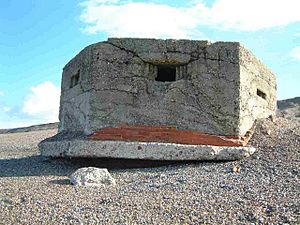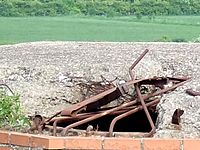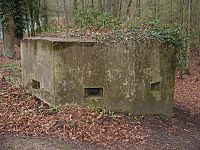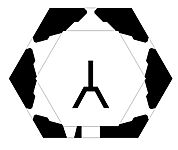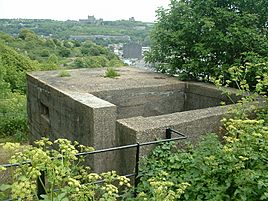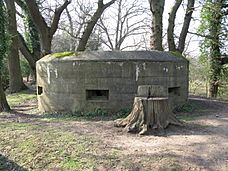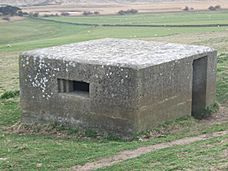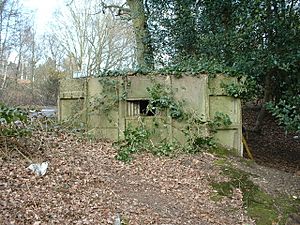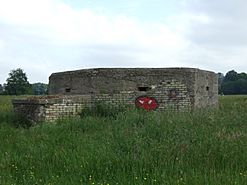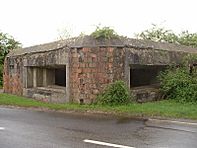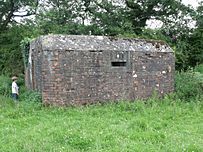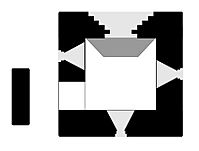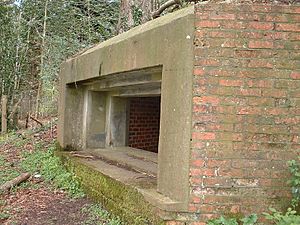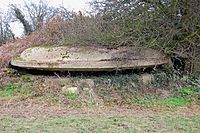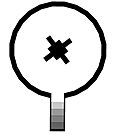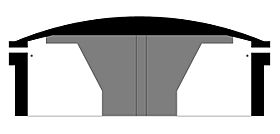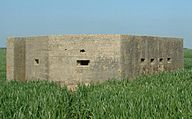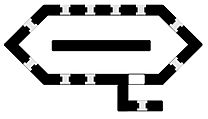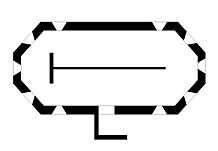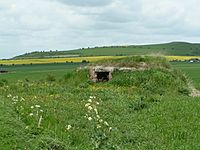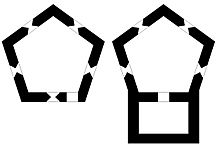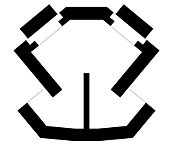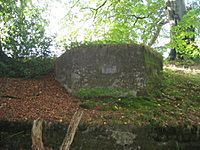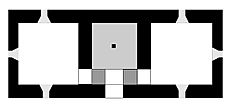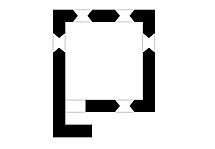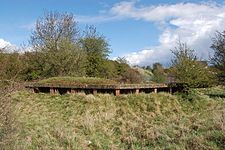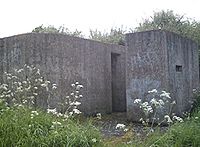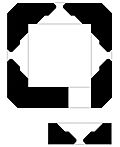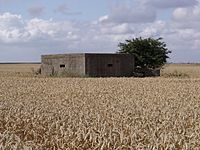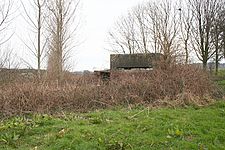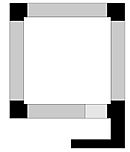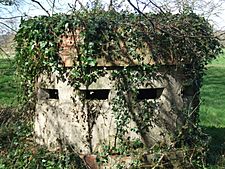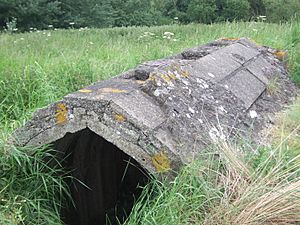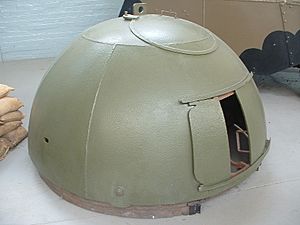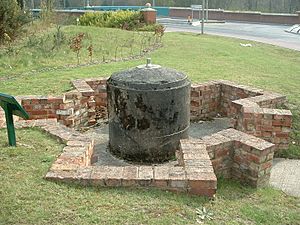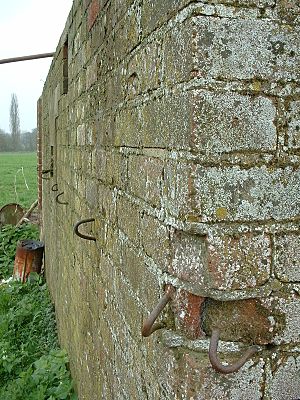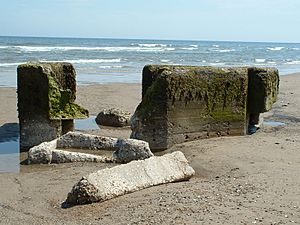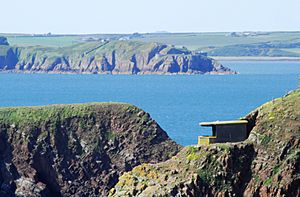British hardened field defences of World War II facts for kids
During World War II, Britain built many small, strong buildings to help defend the country from invasion. People often called these buildings "pillboxes" because they looked a bit like the small boxes used for pills.
Contents
- How Pillboxes Were Made and Changed
- Main Types of Pillboxes
- Other Strong Defences
- Field Gun Positions
- Cantilevered Pillbox
- Lozenge Pillbox
- Essex Lozenge
- Pentagonal Pillbox
- Eared Pillbox
- Northumberland 'D' Type
- Lincolnshire Three-Bay
- Dover Quad
- Suffolk Square
- Section Post / Seagull Trench
- Eastern Command Variants
- ROF Type
- Norcon Pillbox
- Ruck Machine Gun Post
- Pickett-Hamilton Fort
- Allan Williams Turret
- Tett Turret
- Spigot Mortar Position
- Walls and Buildings Used for Defence
- Hiding the Pillboxes (Camouflage)
- What Happened to Them: Gone, Forgotten, Found, and Reused
How Pillboxes Were Made and Changed
The basic designs for pillboxes were often changed to fit the local area and the building materials available. This meant that two pillboxes of the same design could look very different!
Pillboxes could be built at different heights. Some were half-buried in the ground, so their shooting holes were low. Others were raised up for a better view. If a pillbox was built into a hillside, it might not have shooting holes on all sides. The entrance could also be moved or changed, and sometimes extra walls were added to protect it.
The way a pillbox looked also depended on the materials used. All the main designs were made from strong concrete with metal bars inside (called rebars) to make them even stronger. Sometimes, bricks were used as a mould for the concrete and left in place. Other times, wooden planks or corrugated iron were used as moulds, and these were usually removed. Builders often used whatever materials they could find nearby, like sand and pebbles from a beach. This helped the pillboxes blend in with their surroundings, making them harder to spot. Sometimes, even old bed frames or park railings were used as scrap metal inside the concrete!
Local army leaders sometimes changed the standard designs or created their own unique ones. A few pillboxes were even built during World War I and reused.
Main Types of Pillboxes
Here are some of the most common types of pillboxes and how many are still standing today.
Type 22: The Hexagon
The Type 22 pillbox has a regular six-sided shape, like a hexagon. It has shooting holes on five of its sides and an entrance on the sixth. These shooting holes were designed for rifles or light machine guns. Some even had a low entrance with an extra shooting hole above it. Each wall is about 6 feet (1.8 meters) long.
Most Type 22s were built to be strong against bullets, with walls about 12 inches (30 cm) thick. But some were made even stronger, with walls up to 40 inches (1 meter) thick, to protect against shells. Inside, there's a Y- or T-shaped wall. This wall helped stop bullets from bouncing around inside and also supported the roof.
The Type 22 is the second most common pillbox, with 1,347 still existing. It can sometimes be confused with the Type 24, which is also six-sided but not regular.
Type 23: The Rectangle with an Open Top
The Type 23 pillbox is shaped like a rectangle. It has two main parts: one part is covered by a roof and has shooting holes for rifles or light machine guns. The other part is open to the sky and was used for a light anti-aircraft gun, like a Bren or Lewis gun, to shoot at enemy planes.
Usually, there wasn't a door at ground level. To get in, soldiers had to climb over a wall into the open section, then go through a door into the covered part. These pillboxes were typically 8 feet (2.4 meters) wide and 16 feet (4.9 meters) long, with walls about 12 inches (30 cm) thick to stop bullets.
The Type 23 is not very common, with only 87 still standing.
Type 24: The Irregular Hexagon
The Type 24 pillbox has an irregular six-sided shape. The back wall is the longest, about 14 feet (4.3 meters) long, and has the entrance with a shooting hole on each side. The other walls are shorter, about 7 to 8 feet (2.2 to 2.5 meters), each with one shooting hole for rifles or light machine guns.
Inside, there's a Y-shaped wall to stop bullets from bouncing, which also helps support the roof. Type 24s were always built to be strong against bullets (12 inches or 30 cm thick walls) and often even thicker.
A special local version, called a "Mowlem Drum," was built along the River Wey in Surrey. These were Type 24s that had very thick, round outer walls. There are 25 Mowlem Drums still standing.
The Type 24 is the most common pillbox, with over 1,724 still existing.
Type 25: The Round Pillbox
The Type 25 is the only pillbox design that is completely round, with a diameter of about 8 feet (2.4 meters). Its walls were only 12 inches (30 cm) thick, and it had no inner walls. It had three shooting holes for rifles or light machine guns and a small, low entrance.
This design was made using corrugated iron as a mould, which gave it the popular name "Armco" after a company that made corrugated iron.
The Type 25 is quite rare, with only about 30 still existing.
Type 26: The Simple Square
The Type 26 is a simple square-shaped pillbox, with each wall about 10 feet (3 meters) long. It has a door on one side and shooting holes in the other three walls, sometimes with an extra one near the door. There are no inner walls. The shooting holes were for rifles or light machine guns. The walls were usually about 18 inches (46 cm) thick to stop bullets.
There was also an important version of the Type 26 that was built from pre-made concrete slabs that slotted together. This type was known as the "Stent" after the company that made the parts.
The Type 26 is not very common, with 140 still existing, including the Stent type.
Type 27: The Big Octagon
The Type 27 is one of the largest pillbox designs. It has an eight-sided shape (octagonal) with walls between 9 feet 9 inches and 11 feet 6 inches (3.0–3.5 meters) long. The outer walls are 36 inches (91 cm) thick and have shooting holes for rifles or light machine guns on each side. It has an open area in the middle, open to the sky, which could be used for a light anti-aircraft gun.
The Type 27 is uncommon, with 84 still existing.
Type 28: The Anti-Tank Giant
The Type 28 is the biggest of the main pillbox designs and the only one specifically made to stop tanks. It's almost square, with the front corners cut off. The walls are about 20 by 19 feet (6.1 by 5.8 meters) long and are very thick, about 42 inches (107 cm), to protect against shells. It has a very large shooting hole at the front.
This pillbox was designed to hold a 2-pounder or 6-pounder anti-tank gun. The gun's shield would mostly fill the opening. There are usually also shooting holes for rifles or light machine guns on the two side walls.
A common version, the Type 28A, is wider than the regular Type 28. It has an extra area inside for infantry soldiers, with a shooting hole facing forward for a rifle or light machine gun. This helped protect the pillbox from infantry attacks from the front.
A rare version, the Type 28A twin, has two large gun shooting holes on nearby walls, giving two possible firing spots for one main gun, plus two infantry areas.
These pillboxes were usually placed to fire along specific lines, like across an anti-tank ditch or at a bridge. The gun could only turn about 60 degrees, but this wasn't a problem in these fixed positions, and the small shooting hole gave better protection to the gun and its crew.
The Type 28 and its versions are fairly common: 78 Type 28s, 209 Type 28As, and 19 Type 28 twins are still standing.
Vickers Machine Gun Post
The Vickers machine gun pillbox is mostly square, with the front corners cut off. The walls are about 14 feet (4.3 meters) long. There's usually a separate wall outside the entrance to protect against blasts. The walls were very thick, about 36 inches (91 cm), to protect against shells. There are no inner walls.
Inside, there's a large shooting hole and a concrete, trapezoid-shaped table to mount the Vickers machine gun. The other walls would each have a shooting hole for a rifle or light machine gun.
These pillboxes were often built in pairs and were sometimes covered with earth. Just over 75 of these specific Vickers machine gun posts are still standing, but there are many local versions.
Other Strong Defences
Field Gun Positions
There were many different types of field gun positions. Most looked like bigger versions of the Type 28 pillbox. About 50 of them are still standing.
Cantilevered Pillbox
The Cantilevered pillbox was designed to defend airfields. Its special design allowed a 360-degree shooting hole, meaning soldiers could shoot in all directions at enemy troops landing from the air. A cross-shaped pillar in the middle helped stop bullets from bouncing. Weapons were mounted on a rail so they could turn all the way around. This type is also called an F.C. Type, Mushroom Type, or Oakington Type. There are 53 of these still standing.
Lozenge Pillbox
The lozenge pillbox is only found in the North East of England. It has an irregular six-sided shape, with the front and back walls much longer than the others. This allowed for four shooting holes facing forward. The back wall has two shooting holes and an entrance. The four short walls each have one shooting hole. Inside, a wall runs lengthwise to stop bullets from bouncing. It was designed for soldiers with rifles and light machine guns. 176 of these are still standing.
Essex Lozenge
The Essex Lozenge is only found along the seawalls in Essex. They are sometimes called "through-the-wall" pillboxes because they seem to go through the seawall. However, the seawalls were actually made taller after the war, partly burying the pillboxes that were originally on top. These pillboxes are large, long eight-sided shapes. They have three shooting holes at the front and back, and two long side walls, each with two shooting holes near the ends. One side has an entrance with a porch. The shooting holes at the front and back were meant to allow firing in both directions, so the pillbox couldn't be easily surrounded. Inside, there's a large wall to stop bullets from bouncing. Most of these pillboxes are now hard to get into because their entrances are buried in the seawall. 36 of them are still standing.
Pentagonal Pillbox
Pentagonal pillboxes, which have five sides, are only found at or near airfields. This suggests they were designed by the Air Ministry, even though no official drawings have been found. They come in different sizes, and some have an extra open area at the back for an anti-aircraft gun. They were usually fitted with special mounts that allowed many different types of weapons to be used. The versions with an anti-aircraft area have four shooting holes, while those without have five, one in the middle of each side. The door is usually offset to make room for the fifth shooting hole.
Eared Pillbox
Like the lozenge pillbox, the eared pillbox is only found in the North East of England. It has an irregular six-sided shape. It has two large shooting holes designed for medium machine guns. There's a bulge at the bottom of the wall below the shooting holes, which is thought to have held the machine gun's cooling system. Inside, there's a short wall to stop bullets from bouncing.
The two shooting holes are angled about 80 degrees from each other, allowing fire over a wide area (about 180 degrees), but not directly behind the pillbox. These pillboxes are often found on or near beaches, perfect for firing along the coastline. They have two entrances, facing the same direction as the shooting holes. Only 16 of these are still standing.
Northumberland 'D' Type
The D Type pillbox is unique to Northumberland, named for its D-shaped design. It looks a bit like a Type 24 from the front, with three angled faces about 2 meters long. However, its side walls are very short (about 1 meter) and parallel, with no shooting holes. The back wall is about 5 meters long and has two shooting holes in examples that aren't partly buried. The entrance is in the middle of the back wall. 17 of these pillboxes have been found.
Lincolnshire Three-Bay
Found only in Lincolnshire, this pillbox is a changed version of the Type 23. It has an open area in the middle for a light anti-aircraft gun, and fully enclosed sections at each end. 44 of these are still standing.
Dover Quad
The Dover Quad pillbox is a 13-foot (4-meter) square pillbox with wide shooting holes and a roof that hangs over. This design is only found in the Dover area of England, often in high places. Some people think the Dover Quad wasn't a great design because the overhanging roof could make bullets bounce into the wide shooting holes, which didn't offer enough protection. It's possible these were some of the first World War II pillboxes built. 24 of these are still standing.
Suffolk Square
The Suffolk Square, as its name suggests, is only found in Suffolk. It's a square pillbox with walls about 12 feet 6 inches (3.8 meters) long, similar to a Type 26 but a bit bigger. The walls are thin, about 1 foot 6 inches (46 cm). They were often built with concrete blocks and have two shooting holes in the front and one in each of the other sides. Some have a covered porch protecting the entrance. 37 of these are still standing.
Section Post / Seagull Trench
Section posts were like strong, hardened trenches. They were built to stop bullets and were often long with many shooting holes. Sometimes they didn't even have a roof. A special type of section post is the "Seagull trench," named because its W-shape looks like a seagull's wings from above. These are mostly found at airfields. 21 Seagull trenches and 26 Section posts are still standing.
Eastern Command Variants
The Eastern Command (a military area) ordered some special versions of pillboxes for their region. The most common is called the "Eastern Command Type," which is a version of the Vickers Machine Gun Post for infantry. It has shooting holes for Bren guns on the three front sides and the entrance at the back, protected by a very thick blast wall. These are mostly found in Essex and Suffolk, with 64 still standing.
Another common type is actually a larger Type 22 pillbox with an open area in the middle for an anti-aircraft gun and thick walls (3 feet 6 inches or 107 cm). These are found mainly along the River Stour stop line, where 113 are still standing.
ROF Type
Royal Ordnance Factories (ROFs) made weapons and supplies for the war, so they were important targets. Smaller ROF sites used a special type of pillbox. These were small, square, flat-roofed pillboxes, usually with long, narrow shooting holes on at least three sides. The door was usually low and protected by a blast wall. In some places, an anti-aircraft position was added to the top, reached by a ladder.
These pillboxes were probably used mainly as guard posts or for watching for fires, but they could also be used for defence if attacked. They were usually about 8 feet (2.4 meters) square and could hold two or three men. About 30 of these are still standing.
Norcon Pillbox
The Norcon was a small, round pillbox named after the company that made it. It was built from a concrete pipe, about 6 feet (1.8 meters) wide and 4 feet (1.2 meters) high. The walls were only 4 inches (10 cm) thick and had several cut-out shooting holes. It was quick to make, with about 20 able to be produced a day. The standard model didn't have a roof; others had a roof made of wood, corrugated iron, and earth. Extra protection came from sandbags. Only 27 of these pillboxes remain.
Ruck Machine Gun Post
The Ruck machine gun post was designed by James Ruck. It was made from pre-made sections, paving slabs, sandbags, and packed earth. These posts were used quite a lot in Lincolnshire and along the east coast of England, but they are now very rare, with only a few still existing.
Pickett-Hamilton Fort
Defending airfields was tricky because any building above ground could be dangerous for planes. The Pickett-Hamilton Fort was a solution: it could be lowered into the ground when planes were operating and raised up when needed using a hydraulic system. Two soldiers would operate light machine guns from inside. They got in through a hatch in the roof. These forts often flooded and weren't strong enough for the heavier planes developed later in the war. 48 of these forts are still standing, though some have been moved.
Allan Williams Turret
This pillbox was a metal turret that could spin all the way around (360 degrees). It sat above a pit lined with steel and brick. It was designed for a machine gun, which could fire through a front shooting hole (protected by shutters) or through a circular opening in the roof for shooting at aircraft. It could use different machine guns like Vickers, Bren, Hotchkiss, or Lewis guns, or even a Boys anti-tank rifle.
The turret was designed by A.H. Williams and made by his company. It could hold two or three men, who had folding seats inside. One man could spin the turret easily.
The manufacturer said four men could dig the hole and set up the turret, ready to fire, in just two hours. Nearly 200 Allan Williams Turrets were made, but because the metal was reused after the war, only 33 remain today.
Tett Turret
The Tett turret was named after its inventor, H. L. Tett. It was a spinning concrete turret mounted on a special bearing that allowed it to turn easily. The turret sat above a pit, which in early designs was made from a standard concrete pipe.
Only five of these were thought to remain, all at the former RAF Hornchurch, but two well-preserved ones were found again in 2014 in Docking, Norfolk.
Spigot Mortar Position
A spigot mortar position was an open-top defence, sometimes made of brick or concrete, but often just an earthwork. Its main feature was a concrete stand in the middle with a stainless steel peg. This stand was for a type of mortar called the Blacker Bombard, which was good at fighting both tanks and soldiers from about 100 to 500 yards (91 to 457 meters) away.
Walls and Buildings Used for Defence
Existing thick walls and strong buildings were often used instead of building new pillboxes. They were turned into defensive positions by simply adding shooting holes. This was convenient and helped them blend in perfectly. For example, an old dairy building in Beaulieu, Hampshire, was made stronger by thickening its walls and making the windows smaller into gun slits, while keeping the original windows on the outside to hide them.
Hiding the Pillboxes (Camouflage)
There were detailed instructions on how to hide pillboxes and other defences, and all of them were camouflaged. Many were dug into the ground or built into a hedgerow or hillside to make them less visible. Others had soil piled on their roofs and sides. Camouflage paint and netting were used to break up their shapes. Builders also used local materials, like concrete made with beach sand or pebbles, to help the defences blend into the background.
Artists were hired to help hide these defences. In towns, pillboxes were disguised to look like part of a nearby building, carefully matched and given a roof to make them seem like they had always been there. Sometimes, they were even built inside existing buildings!
Some pillboxes were cleverly built to look like something completely different and harmless, like a haystack, an old cottage, a seaside kiosk, a bus stop shelter, or a railway signal box. It was common for them to have a fake sloped roof to help with the disguise. Some of these disguises were quite imaginative!
In some cases, the concrete roof was shaped to make the pillbox's distinct form less obvious from the air. Along part of the Taunton stop line in Somerset, because materials were scarce, six pillboxes were covered with a mix of cow manure, mud, and straw to hide them naturally. Near Axminster, a square pillbox was disguised as a Romany caravan. During summer, a scarecrow "family" and a straw horse were dressed up and placed around the caravan to make it look like a real home, not a manned defence.
What Happened to Them: Gone, Forgotten, Found, and Reused
Most of Britain's wartime defences have been destroyed. This started even before the war ended. Ditches and trenches were filled in, shooting holes were repaired, and wood and metal were recycled.
Farmers whose land was used for these structures were paid after the war to fill in ditches and demolish pillboxes. Today, almost nothing remains of the anti-tank ditches, but at the time, they were very noticeable. A few remain as field drains or boundaries, while others can only be seen as marks in crops. For pillboxes, a small amount of money (sometimes £5) was offered for demolition, but it was very hard to break them down. It seems most farmers kept the money as compensation instead.
Today, it's rare to find any parts of Britain's defences other than those made of concrete. Right after the war, people had more important things to do than save old war structures. For decades, no one suggested saving them, except for those at Pevensey Castle, where the new forts were seen as part of the castle's history.
As years passed, erosion and new buildings destroyed many structures. Along the coast, forts have fallen into the sea or sunk into the sand. Others have been removed for road improvements or new developments. Many that remain are now hidden by nature, even better than they were during the war.
Years after the war, memories faded. People started to think that the few pillboxes they could see were all that was done to defend Britain, and that their purpose was just to boost morale, with no real hope of stopping a German attack. Even the Home Guard was sometimes seen as a joke, like in the TV show Dad's Army. However, what we see today are just the strongest parts of a huge defence program built very quickly.
Old wartime records were thought to be poor, and no one knew how many pillboxes had survived or how many were built in the first place. In the late 1970s, a journalist named Henry Wills started researching them. His work led to more interest, and local surveys were done. These surveys led to the Defence of Britain Project (1995-2002), which tried to record all known military defence sites. From this project and other surveys, it's believed that about 28,000 pillboxes and other strong field forts were built in the UK, and about 6,500 of them still exist.
Many pillboxes have found new uses. The Type 28s, being large inside with a big back entrance, are often reused. On farms and in gardens, they are used as cattle sheds or storage lockers. Other creative uses include a pub cellar, a ladies' toilet, and an open-air theatre box office!
Some pillboxes have been changed to create homes for bats. Pillboxes that are well-dug-in and have thick walls are naturally damp and have a steady temperature, which bats need for hibernation, just like caves. With a few small changes, suitable pillboxes can become artificial caves for bats.
|


